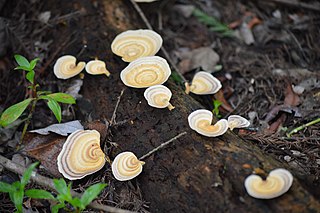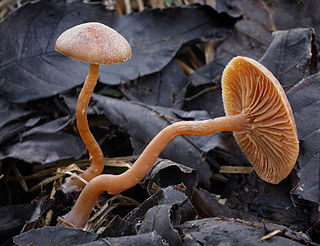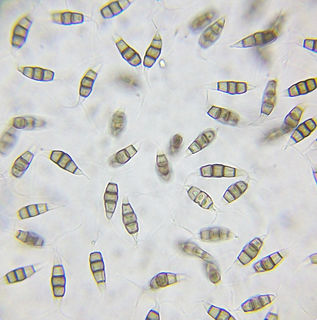Related Research Articles
Scutula is a genus of lichenicolous fungi in the family Ramalinaceae.

The Hysteriaceae are a taxonomic family of fungi and the only extant family of the order Hysteriales. Members of the Hysteriaceae are defined by the possession of a sexual structure called the hysterothecium, an elongated structure that opens by a longitudinal slit and releases sexually produced spores. The family is widely distributed, with many species found in temperate regions, and most are saprobic on wood and bark, although a few are parasitic on plants.

Lentinus is a genus of fungi in the family Polyporaceae. The genus is widely distributed, with many species found in subtropical regions.
Gnomoniella is a genus of fungi in the family Gnomoniaceae. The genus contains 13 species. Gnomoniopsis is a genus of fungi in the family Gnomoniaceae including:

Irpex is a genus of corticioid fungi in the order Polyporales. Species produce fruit bodies that grow as a crust on the surface of dead hardwoods. The crust features an irpicioid spore-bearing surface, meaning it has irregular and flattened teeth. Irpex is distinguished from the similar genera Junghuhnia and Steccherinum by the simple septa found in the generative hyphae.

Favolus, or honeycomb fungus, is a genus of fungi in the family Polyporaceae. The fruit bodies of Favolus species are fleshy with radially arranged pores on the underside of the cap that are angular and deeply pitted, somewhat resembling a honeycomb.
Grammothele is a genus of poroid crust fungi in the family Polyporaceae.

Microporellus is a genus of poroid fungi in the family Polyporaceae.

Podospora is a genus of fungi in the family Podosporaceae.

Tubaria is a genus of fungi in the family Tubariaceae. The genus is widely distributed, especially in temperate regions. Tubaria was originally named as a subgenus of Agaricus by Worthington George Smith in 1870. Claude Casimir Gillet promoted it to generic status in 1876. The mushrooms produced by species in this genus are small- to medium-sized with caps ranging in color from pale pinkish-brown to reddish-brown, and often with remnants of the partial veil adhering to the margin. Mushrooms fruit on rotting wood, or, less frequently, in the soil. There are no species in the genus that are recommended for consumption.

Otidea is a genus of fungi in the family Pyronemataceae. The genus is widely distributed in northern temperate regions.

Job Bicknell Ellis was a pioneering North American mycologist known for his study of the Ascomycetes, especially the grouping of fungi called the Pyrenomycetes. Born and raised in New York, he worked as a teacher and farmer before developing an interest in mycology. He collected specimens extensively, and together with his wife, prepared 200,000 sets of dried fungal samples that were sent out to subscribers in series between 1878 and 1894. Together with colleagues William A. Kellerman and Benjamin Matlack Everhart, he founded the Journal of Mycology in 1885, forerunner to the modern journal Mycologia. He described over 4000 species of fungi, and his collection of over 100,000 specimens is currently housed at the herbarium of the New York Botanical Gardens. Ellis had over 100 taxa of fungi named in his honor.

Pestalotiopsis microspora is a species of endophytic fungus capable of breaking down and digesting polyurethane. Originally identified in fallen foliage of common ivy in Buenos Aires, it also causes leaf spot in Hypericum 'Hidcote' shrubs in Japan.

Coccomyces dentatus is a species of fungus in the family Rhytismataceae. A widespread species, particularly in temperate areas, it colonizes the dead fallen leaves of vascular plants, particularly oak and chestnut. The fungus apothecia, which form in the epidermal layer of the leaf host, resemble dark hexagonal spots scattered on a multi-colored mosaic pattern bounded by thin black lines. When mature, the apothecia open by triangular flaps to release spores. The anamorph form of C. dentatus is Tricladiopsis flagelliformis. Lookalike species can be distinguished by the shape of the apothecia, or by microscopic characteristics.
Pluteus aethalus is a species of agaric fungus in the family Pluteaceae. It is found in Cuba. The species was originally named Agaricus aethalus by Miles Joseph Berkeley & Moses Ashley Curtis in 1869, and later transferred to the genus Pluteus by Pier Andrea Saccardo in 1887. It is classified in Pluteus section Celluloderma, subsection Mixtini.

Elias Judah Durand was an American mycologist, and botanist. He was one of the foremost American experts on the discomycetes.

Isaria is a genus of fungi mostly in the order Hypocreales and family Clavicipitaceae, or by some authorities the Cordycipitaceae. It includes a large number of entomopathogenic species, some of them exploited as biopesticides : often previously assigned to the genus Paecilomyces.

Cordieritidaceae is a family of fungi in the order Cyttariales. Species in this family are saprobes or lichenicolous.
References
- ↑ "Synonymy: Vizella Sacc". Species Fungorum. CAB International. Retrieved 2016-01-11.CS1 maint: discouraged parameter (link)
- ↑ Swart HJ. (1971). "Australian leaf-inhabiting fungi. I. Two species of Vizella". Transactions of the British Mycological Society. 57 (3): 455–464. doi:10.1016/s0007-1536(71)80061-x.
- ↑ Saccardo PA. (1883). Sylloge Pyrenomycetum (in Latin). 2. Patavii, Italy: Typis Seminarii. p. 662.
- ↑ Selkirk DR. (1972). "Fossil Manginula-like fungi and their classification". Proceedings of the Linnean Society of New South Wales. 97: 141–149.
- ↑ Batista AC, Ciferri R. (1957). "Contribuição ao estudo dos Ascomicetos Pernambucanos". Beihefte zur Sydowia (in Spanish). 1: 325–341.
- ↑ Johnston PR. (2000). "Vizella metrosideri sp. nov". New Zealand Journal of Botany. 38 (4): 629–633. doi: 10.1080/0028825x.2000.9512710 .
- ↑ Sivanesan A. (1973). "New species of Vizella on Pycnanthus". Transactions of the British Mycological Society. 60 (3): 586–588. doi:10.1016/s0007-1536(73)80045-2.